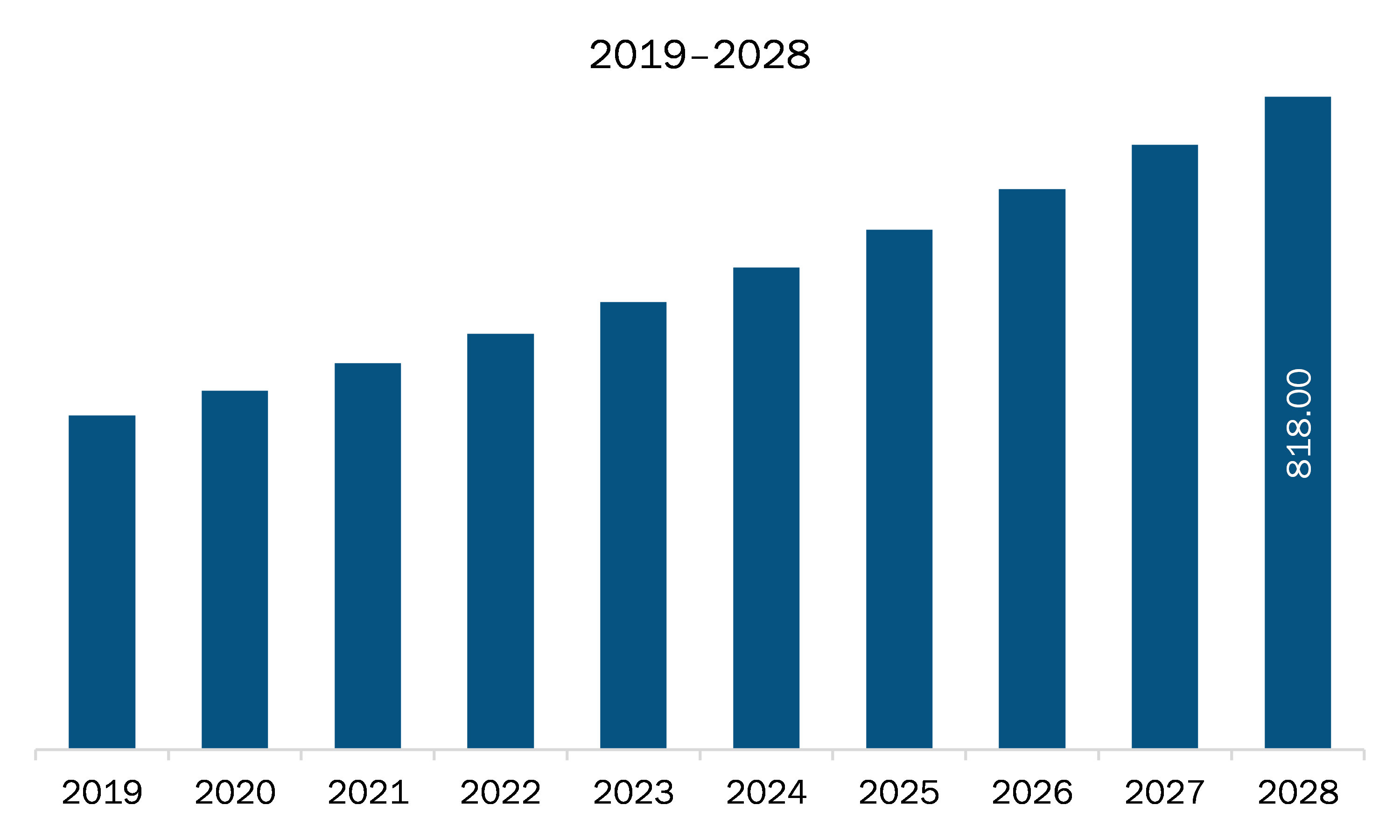The APAC immunohistochemistry market is expected to grow from US$ 483.76 million in 2021 to US$ 818.00 million by 2028; it is estimated to grow at a CAGR of 7.8% from 2021 to 2028.
China, Japan, India, Australia, and South Korea are major economies in APAC. Burgeoning opportunities in emerging countries is expected to fuel the market growth. The emerging markets across the region are creating significant opportunities for the key market players to expand their business. It is likely to be a prime factor contributing to the market growth during the coming years. Majority of the players concentrate on developing markets, owing to the large population suffering from chronic diseases in the region. With rising costs of production against their practices, the healthcare companies are striving to produce sufficient revenue to entertain their investors. The markets in some growing economies are expected to be an essential part of offering more reliable and profitable growth opportunities for the major players to expand their industry scope. Advancements in biotechnology have increased the demand for diagnostics in the healthcare market, encouraging the introduction of a more significant number of immunoassay systems and facilitating the shift toward personalized medicine. There are new opportunities in infectious disease testing, molecular oncology, and pharmacogenomics in emerging countries. Hence, healthcare companies can target patients or consumers in the region. There has been an increase in the healthcare expenditure of the countries during the previous years. Various players in the industry have been investing a significant amount of their revenue in research and development activities for the development of better and advanced products and technologies to be used in the healthcare industry. Presence of significant biopharmaceutical companies in the region and the growing number of local companies are the factors contributing to the market growth in the region. These activities in the region are increasing the demand for immunohistochemistry. Thus, the rising number of infectious disease incidences and advancements in emerging countries are likely to boost the market and are anticipated to provide significant growth opportunities to the players operating in the APAC market during the forecast period.
Countries in APAC, especially India, are highly affected due to the COVID-19 outbreak. The supply chain disturbances and the tremendous demand for efficient treatments for the therapy of COVID-19 have put the healthcare research industry in a crucial situation in APAC. Prohibitive measures have been taken to control the spread of the novel coronavirus. The COVID-19 pandemic has adversely affected economies in the region. The socioeconomics was severely affected, rising in negative inflation, GDPs, and a regional unemployment surge. Countries, such as China, Japan, Singapore, and South Korea, are seeing an increased interest in clinical trials. High costs in western countries are also contributing to the flow of medical affairs outsourcing to APAC. To expand sales to the Asian market, pharmaceutical companies are becoming aware of new and changing regulatory environments for drugs, devices, and in-vitro diagnostics. New or improved regulations are implemented frequently in Asia, including changes in GMP standards, drug price controls, and medical device regulatory systems. Third-party guidance and advice are required as a part of any acquisition or any improvement of current standards. Increasingly, third-party outsourcing service providers are playing a significant role in supporting the associated market in APAC. However, the market has stabilized compared to the initial phases of the pandemic owing to the control procedures, awareness among people, vaccination availability, and supportive government policies of the business in the related market.
With the new features and technologies, vendors can attract new customers and expand their footprints in emerging markets. This factor is likely to drive the APAC immunohistochemistry market. The APAC immunohistochemistry market is expected to grow at a good CAGR during the forecast period.

- This FREE sample will include data analysis, ranging from market trends to estimates and forecasts.
APAC Immunohistochemistry Market Segmentation
APAC Immunohistochemistry Market – By Product
- Equipment
- Slide Staining Systems
- Tissue Microarray Systems
- Tissue Processing Systems
- Slide Scanners
- Other Equipment
- Antibodies
- Primary Antibodies
- Secondary Antibodies
- Reagents
- Histological Stains
- Blocking and Fixation Reagents
- Chromogenic Substrates
- Fixation Reagents
- Stabilizers
- Organic Solvents
- Proteolytic Enzymes
- Diluents
- Kits
APAC Immunohistochemistry Market – By Application
- Diagnostics
- Cancer
- Infectious Diseases
- Autoimmune Diseases
- Diabetes Mellitus
- Nephrological Diseases
- Others
- Drug Testing
APAC Immunohistochemistry Market – By End User
- Hospitals and Diagnostic Laboratories
- Research Institutes
- Others
APAC Immunohistochemistry Market, by Country
- China
- Japan
- India
- Australia
- South Korea
- Rest of APAC
APAC Immunohistochemistry Market - Companies Mentioned
- Abcam plc
- Agilent Technologies, Inc.
- Bio SB
- BIO-RAD LABORATORIES INC.
- Cell Signaling Technology, Inc.
- Danaher
- F. HOFFMANN-LA ROCHE LTD.
- MERCK KGaA
- PerkinElmer Inc.
- THERMO FISHER SCIENTIFIC INC.
Asia Pacific Immunohistochemistry Report Scope
| Report Attribute | Details |
|---|---|
| Market size in 2021 | US$ 483.76 Million |
| Market Size by 2028 | US$ 818.00 Million |
| CAGR (2021 - 2028) | 7.8% |
| Historical Data | 2019-2020 |
| Forecast period | 2022-2028 |
| Segments Covered |
By Application
|
| Regions and Countries Covered |
Asia-Pacific
|
| Market leaders and key company profiles |
|
- Historical Analysis (2 Years), Base Year, Forecast (7 Years) with CAGR
- PEST and SWOT Analysis
- Market Size Value / Volume - Regional, Country
- Industry and Competitive Landscape
- Excel Dataset
Recent Reports
Testimonials
Reason to Buy
- Informed Decision-Making
- Understanding Market Dynamics
- Competitive Analysis
- Identifying Emerging Markets
- Customer Insights
- Market Forecasts
- Risk Mitigation
- Boosting Operational Efficiency
- Strategic Planning
- Investment Justification
- Tracking Industry Innovations
- Aligning with Regulatory Trends





















 Get Free Sample For
Get Free Sample For